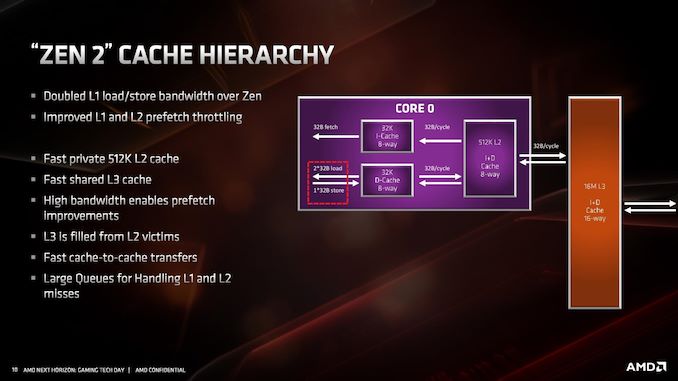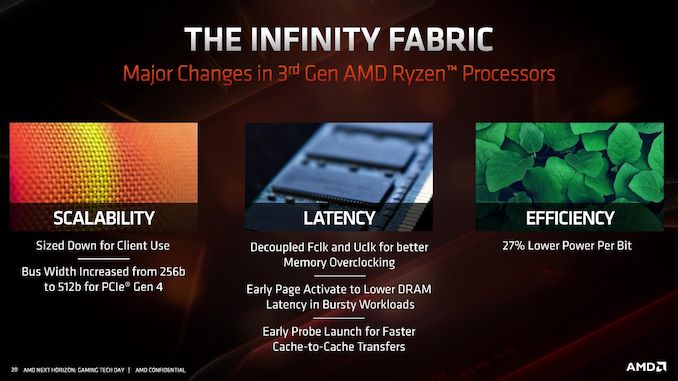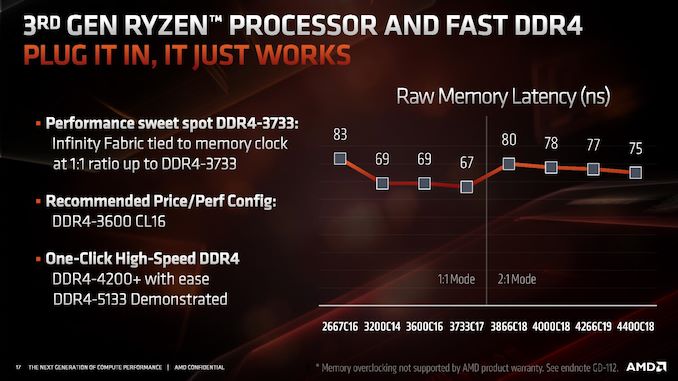AMD Zen 2 Microarchitecture Analysis: Ryzen 3000 and EPYC Rome
by Dr. Ian Cutress on June 10, 2019 7:22 PM EST- Posted in
- CPUs
- AMD
- Ryzen
- EPYC
- Infinity Fabric
- PCIe 4.0
- Zen 2
- Rome
- Ryzen 3000
- Ryzen 3rd Gen
Cache and Infinity Fabric
If it hasn’t been hammered in already, the big change in the cache is the L1 instruction cache which has been reduced from 64 KB to 32 KB, but the associativity has increased from 4-way to 8-way. This change enabled AMD to increase the size of the micro-op cache from 2K entry to 4K entry, and AMD felt that this gave a better performance balance with how modern workloads are evolving.
The L1-D cache is still 32KB 8-way, while the L2 cache is still 512KB 8-way. The L3 cache, which is a non-inclusive cache (compared to the L2 inclusive cache), has now doubled in size to 16 MB per core complex, up from 8 MB. AMD manages its L3 by sharing a 16MB block per CCX, rather than enabling access to any L3 from any core.
Because of the increase in size of the L3, latency has increased slightly. L1 is still 4-cycle, L2 is still 12-cycle, but L3 has increased from ~35 cycle to ~40 cycle (this is a characteristic of larger caches, they end up being slightly slower latency; it’s an interesting trade off to measure). AMD has stated that it has increased the size of the queues handling L1 and L2 misses, although hasn’t elaborated as to how big they now are.
Infinity Fabric
With the move to Zen 2, we also move to the second generation of Infinity Fabric. One of the major updates with IF2 is the support of PCIe 4.0, and thus the increase of the bus width from 256-bit to 512-bit.
Overall efficiency of IF2 has improved 27% according to AMD, leading to a lower power per bit. As we move to more IF links in EPYC, this will become very important as data is transferred from chiplet to IO die.
One of the features of IF2 is that the clock has been decoupled from the main DRAM clock. In Zen and Zen+, the IF frequency was coupled to the DRAM frequency, which led to some interesting scenarios where the memory could go a lot faster but the limitations in the IF meant that they were both limited by the lock-step nature of the clock. For Zen 2, AMD has introduced ratios to the IF2, enabling a 1:1 normal ratio or a 2:1 ratio that reduces the IF2 clock in half.
This ratio should automatically come into play around DDR4-3600 or DDR4-3800, but it does mean that IF2 clock does reduce in half, which has a knock on effect with respect to bandwidth. It should be noted that even if the DRAM frequency is high, having a slower IF frequency will likely limit the raw performance gain from that faster memory. AMD recommends keeping the ratio at a 1:1 around DDR4-3600, and instead optimizing sub-timings at that speed.













216 Comments
View All Comments
mikato - Tuesday, June 11, 2019 - link
Hehe, yeah I saw that. That was a good one for the marketing team or whoever makes the slides.Atari2600 - Wednesday, June 12, 2019 - link
No, for each of those line items they should have said "Intel only"zalves - Tuesday, June 11, 2019 - link
I really don't understand how one can compare these AMD CPU's with Intel's HEDT, they lack PCIe Lanes and don't support quad-channel memory. And that a huge deal breaker for anyone that wants and needs some serious IO and multi tasking.TheUnhandledException - Tuesday, June 11, 2019 - link
Well that is what Threadripper is for. Can't wait to see the 3000 series Threadrippers.John_M - Tuesday, June 11, 2019 - link
So, 5th generation EPYC codename is going to be either Turin, Bolognia or Florence as Palermo has already been used for Sempron.John_M - Tuesday, June 11, 2019 - link
*that's Bologna, of course. It would be nice to be able to edit posts for typos.WaltC - Tuesday, June 11, 2019 - link
Great read!John_M - Tuesday, June 11, 2019 - link
What is the advantage in halving the L1 instruction cache? Was the change forced by the doubling of its associativity? According to the (I suspect somewhat oversimplified) Wikipedia article on CPU Cache, doubling the associativity increases the probability of a hit by about the same amount as doubling the cache size, but with more complexity. So how is this Zen2 configuration better than that in Zen and Zen+?John_M - Tuesday, June 11, 2019 - link
Ah! It's sort of explained at the bottom of page 7. I had glossed over that because the first two paragraphs were too technical for my understanding. I see that it was halved to make room for something else to be made bigger, which on balance seems to be a successful trade off.arnd - Wednesday, June 12, 2019 - link
More importantly, 32K 8-way is a sweet spot for an L1 cache. This is what AMD is using for the D$ already and what all modern Intel L1 caches (both I and D) are. With eight ways, this is the largest size you can have for a non-aliasing virtually indexed cache using the 4KB page size of the x86 architecture. Having more than eight ways has diminishing returns, so going beyond 32KB requires extra complexity for dealing with aliasing or physically indexed caches like the L2.